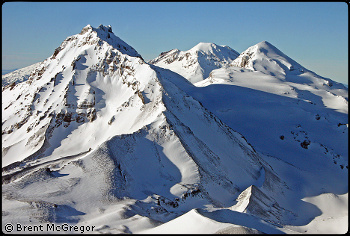 |
 was intrigued, to say the least. I had heard numerous
“marathon” stories after moving to Bend, Oregon. Stirring
tales from Rod Ray, David Newbold and Mark Chidlaw circulated around the
labs and offices at Bend Research, where I worked.
was intrigued, to say the least. I had heard numerous
“marathon” stories after moving to Bend, Oregon. Stirring
tales from Rod Ray, David Newbold and Mark Chidlaw circulated around the
labs and offices at Bend Research, where I worked.
“I remember cramping up while climbing South Sister,”
recalled Chidlaw. “I didn’t drink enough water throughout
the day. We didn’t know as much about proper nutrition and
hydration in the late eighties.” Stories about the traverse also
emerged from friends who had completed the marathon several times in good
form, including Jack Hart, Scott Johnston and Ben Husaby. Countless
others have summitted all three peaks in a day or have fallen just shy of
the goal due to sketchy conditions on North Sister. I wanted to add my
name to that distinguished list.
On Foot
Inspired by fellow climbers and their stories, I decided to give the
marathon a go—abruptly. I asked my friend Max King if he wanted to
do the Three Sisters marathon the following day. It was a Friday
afternoon in August 2003, and we were finishing up some work in the lab.
Although the marathon had been on my list for a couple years, Max and I
had never discussed it together.
Max’s resume as an endurance athlete is one that few people can
rival, so I knew he would be the perfect partner for the day. He also
has the endless supply of energy and enthusiasm required for a long
grueling day in the mountains. He agreed to the plan without
hesitation.
At 5 o’clock sharp the next morning, I picked him up. We
departed from sleepy downtown Bend while eating breakfast burritos packed
with the energy we would need to get us up three peaks. It was August,
and a hint of early autumn was in the air as we started from the Pole
Creek trailhead out of Sisters. I started my stopwatch at 6:05—the
beginning of my hidden agenda.
The Three Sisters marathon entails climbing North, Middle and South
Sisters (also known as Faith, Hope and Charity) all in one day. The game
began back in 1931, when three members of the Obsidians, an outdoor club
from Eugene, completed the adventure. Don Woods, Ed Johnson and Clifford
Stalsberg climbed the three mountains from a camp at the base of North
Sister to the Green Lakes summer camp in about 16-1/2 hours.
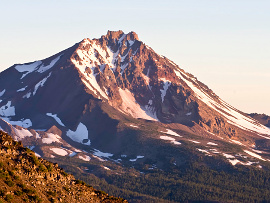 North Sister from the east in summer. Photo © Brent McGregor. |
|
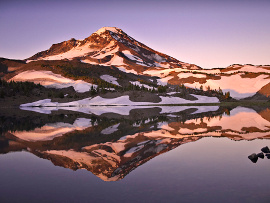 South Sister from Camp Lake. Photo © Brent McGregor. |
| North Sister from the east in summer. Photo © Brent McGregor. |
|
South Sister from Camp Lake. Photo © Brent McGregor. |
Neither Max nor I had climbed North Sister before, so the excitement
and anticipation of the day grew as we took off down the trail. Staying
on the trail for speed, we quickly covered the first several miles before
crossing Soap Creek. Beyond the creek, we reveled in the late season
colors as we hiked up the trail heading toward Camp Lake. A few minutes
farther along the trail, our instincts told us to leave the path and make
our way toward the southeast ridge of North Sister.
We easily made our way through the open pine forest. Above treeline,
we gained the ridge and traversed around one pinnacle after another until
we reached the technical crux of the day. The west side of North Sister
is a steep, exposed flank of rubble which, depending on the time of year,
can be covered with ice. This late in the year, the traverse beneath
Prouty Pinnacle was nearly free of snow and ice, but the footing still
demanded attention. I initially led us too high, and we had to retrace
our steps and try a lower traverse.
We crossed to the Bowling Alley chute, where the pitch increases but
the rock quality improves, making it more enjoyable to climb. To save
weight, we had brought no climbing gear, so we had to rely on careful
routefinding to pick our way up chute. Three hours and 22 minutes after
setting out we stood on the summit of our first prize, North Sister.
Climbing a mountain is only half the battle; getting back down is often
the greater challenge. To continue to Middle Sister, we had to descend
the same route we had climbed, reversing the Bowling Alley and the Prouty
Pinnacle traverse.
Energy bars and water replenished our energy reserves. As we headed
off toward Middle Sister, I wondered what the Obsidian climbers had in
their rucksacks more than 75 years ago, and how they had felt when they
had made the first successful linkup.
Mountain scree is a sea of small loose rocks that are maddening to
climb up—like sprinting in sand—but forgiving when
you’re going downhill. We “scree-skied” down the
southwest shoulder of North Sister on our way to the Middle-North saddle.
From that point we could ascend the north ridge of Middle Sister. After
some sweat and effort, one hour and 46 minutes after leaving the summit
of North Sister, we stood on the summit of Middle Sister. We ate lunch
on the summit. A peanut butter and honey sandwich always tastes good,
but it is even better on the top of Middle Sister.
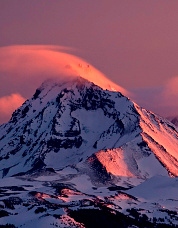 Winter cloudcap. Photo © Brent McGregor. |
|
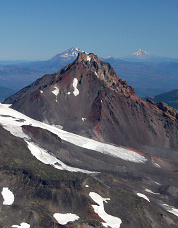 High summer. Photo © Brent McGregor. |
|
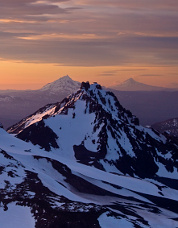 Spring sunset. Photo © Brent McGregor. |
| Winter cloudcap. Photo © Brent McGregor. |
|
High summer. Photo © Brent McGregor. |
|
Spring sunset. Photo © Brent McGregor. |
It was 11:13 a.m. and we were just over five hours into the Three
Sisters marathon. Dropping down the south side of Middle Sister is like
walking down a slope covered with basketballs. Like most Oregon
stratovolcanoes, the rock is loose and chossy. Large, loose boulders
covering the sidehill made for a delicate descent and a climber has to be
alert for rolling boulders.
As we crossed Chambers Lakes basin, encroaching clouds and a cool
breeze made for nice traveling. We heading for the direct north ridge of
South Sister a route I had never traveled before. Half-way up the lower
scree slopes I danced with an oven-sized block that tipped as I pulled on
it. Fortunately, I was able to modify the roll of the block, moving to
one side while bringing it to a stop.
We scrambled through the last cliff-band on the ridge before gaining
the final scree slope below the summit of South Sister. Two hours and 43
minutes after leaving the summit of Middle Sister, we stood on the final
summit of the day just before 2 p.m. Having seen only four so far that
day, the summit of South Sister seemed like an anthill swarming with
nearly twenty climbers.
There was not much time to socialize because my hidden agenda was
pressing. I had set a goal to complete the three-peak traverse in less
than nine hours (which I believed to be roughly the record at that time).
We were eight hours into the day with one descent and one hour left.
“Do you think we can descend in one hour?” I asked King.
His eyes lit up, and off he went, running down the trail. I raced after
him, trying to pass people politely as we quickly ran by. We continued
at a good pace and things were looking good. But five minutes from the
finish line, a root caught my foot sending me headfirst down the trail.
I quickly picked myself up, dusted off, and started running again.
At eight hours and 59 minutes, we crossed the finish line at Devils
Lake trailhead. We had covered roughly 18 miles, ascending over 9,000
feet of elevation, descending another 6,500 feet and completed the Three
Sisters marathon.
My ideal of fun usually involves long adventures in the mountains.
The fresh air, gorgeous scenery, and the physical, mental and technical
challenges of a long day with a friend who can tough it out are what I
crave. The Three Sisters marathon had been all of that for me, and now
my story and King’s would be added to those of the climbers had
inspired me to try it.
|
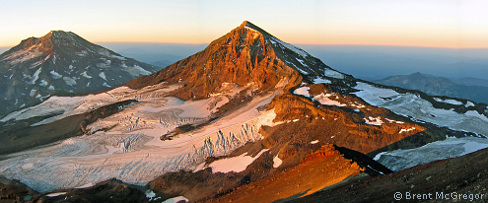 Middle and South Sister in autumn. Photo © Brent McGregor. |
|
| |
Middle and South Sister in autumn. Photo © Brent McGregor. |
|
On Skis
As a long-time skier, my enthusiasm for Cascade traverses reaches a
climax in spring when the mountains are covered with corn snow. Last
spring, I set out to ski Broken Top and the Three Sisters in a single
push on two separate occasions. Both times my partners and I settled for
only three of the peaks, leaving off North Sister.
Jack Hart, Jason Moyer, Chris Williams, and I left the Mount Bachelor
nordic area at 4:30 a.m. in late April 2009, on our first attempt. The
snow had hardened like concrete after a 21-day curing cycle to give us
fast travel conditions. With headlamps illuminating a 6-foot circle in
the snow, we skated through the common corridor onto Century Drive (still
covered in snow). The temperature was mild and I was concerned that the
day might become too warm.
Removing our skis after skating across Todd Lake gave us a chance to
catch our breath and take stock of the day. Attempting this traverse on
skis had been on my mind for three to four years and it felt almost
surreal to finally be giving it a try. After hiking up the steep slope
at the head of Todd Lake, we gained a ridge and starting skinning toward
Broken Top just as the first rays of daylight were starting to appear.
We made our way into the Broken Top crater in good time, and as the sun
began peeking over the horizon we looked down on the sleeping town of
Bend.
I sensed that Jason was struggling a little and not feeling quite up
to par as we approached our first objective. Packing skis at the base of
the 11 o’clock couloir gave us a short break for re-fueling and
hydrating. I shot a little video to document the adventure as we
cramponed up the couloir. Traversing the west face of Broken Top, Jack
found the key to the summit. After wrapping around onto the north face,
a steep snow ramp led us right to the top. The sun shone brightly
warming our bodies and spirits. I thought this was going to be the first
of four summits and that we were going to pull off the four-peak ski
traverse on our first try.
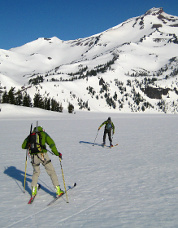 Skating on firm morning snow. Photo © Kevin Grove. |
|
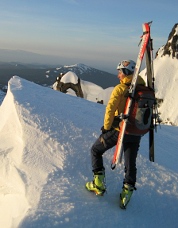 Viewing sunrise from Broken Top. © Kevin Grove. |
|
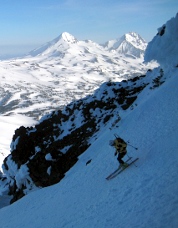 Descending crusty snow in the shade. Photo © Kevin Grove. |
| Skating on firm morning snow. Photo © Kevin Grove. |
|
Viewing sunrise from Broken Top. © Kevin Grove. |
|
Descending crusty snow in the shade. Photo © Kevin Grove. |
Vague tales of people trying the traverse on snow are sometimes heard,
but I know of only one other attempt to do the Three Sisters traverse in
a day on skis. Jonas Tarlin and Shane Fox set out in April 2008, taking
a snowmobile to the Three Sisters Wilderness boundary by Pole Creek.
They climbed to the SE shoulder of North Sister without summiting and
proceeded to summit Middle and South Sister before being picked up by a
snowmobile at Devils Lake to get back to the Mount Bachelor parking lot.
We decided to attempt to summit the Three Sisters and Broken Top without
any snowmobile assist, traveling from south to north.
After enjoying the summit views from Broken Top, we down-climbed 30
meters back to our skis before clicking in to ski the west face down to
Green Lakes. The icy, teeth-chattering concrete was still frozen on the
shady slope. Midway across Green Lakes, Chris and I filled up water
bottles before starting the long climb up South Sister.
About a third of the way up South Sister, our weather and good fortune
began to change. A wind from the west grew in intensity and a cloud bank
developed, blocking the solar rays we needed for warmth. As the climb
progressed, our spirits began to sink. Jason was extremely cold and
still not feeling full strength. Powerful wind gusts knocked Jason and
Chris to the ground more than once.
At the summit of South Sister, talk of retreat began. The snow was
still rock-hard because of the cold wind and lenticular clouds that
prevented the sun’s rays from softening it. We slowly skied and
picked our way down the Prouty Glacier Headwall route on the east face.
Jason noted, “It’s a good thing we brought Chris (a dentist)
along to fix my teeth after that descent.” The whoops and
high-fives that would normally celebrate a corn-snow descent were absent,
and my hopes of completing the traverse on the first try began to fade
like a prayer flag fluttering in the breeze.
After a food and water break, the weak sun warmed our bodies and
increased our motivation. We decided to attempt one more peak and headed
for the south ridge of Middle Sister. While Jason’s energy level
seemed to rebound, Chris’s was dropping. Jack, just back from a
week on the Ortler tour in the Italian Alps, was still charging. After
reaching the summit of Middle Sister, we decided to pull the plug on the
traverse and head out to Pole Creek. One last teeth chattering descent
and a GPS bearing through the woods led us to the Pole Creek trailhead.
Typically the end of the road, the trailhead was still under snow and
another three miles of skiing and hiking ended our journey of 20 miles
and a little over 10,000 vertical feet gain. We had been traveling just
under 12 hours.
|
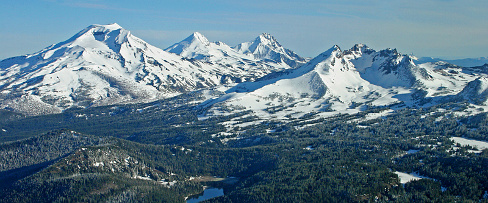 Three Sisters and Broken Top with fine skiing conditions. Photo © Brent McGregor. |
|
| |
Three Sisters and Broken Top with fine skiing conditions. Photo © Brent McGregor. |
|
Happy, but not satisfied, Chris and I attempted the traverse three
weeks later with the same result. The skiing off the Prouty Glacier on
South Sister had us high-fiving this time, but the heat, sloppy snow, and
fatigue from other ski outings sapped our motivation for a fourth peak.
Winter or spring traverses in the Cascades are much more fickle than
those in summer, requiring many stars to align for success. Yet
it’s certain that ski traverses will continue to add chapters to
the lore of the Three Sisters marathon.
|

|
| Marathon Summary |
|
 |
| Logistics
|
 |
|
Route:
The summer marathon is most commonly done from north to south, but
can be done in either direction. To travel from north to south,
leave a shuttle car at the Devils Lake Trailhead on Century Drive and
have someone drop you off at the Pole Creek Trailhead. To reach the
Pole Creek Trailhead, drive 1.6 miles west of Sisters on McKenzie
Highway (State Highway 242) and turn on Pole Creek Spring Road (USFS
15). Follow USFS 15 and USFS 1524 nearly 11 miles to the parking
area and trailhead.
Map:
Three Sisters Recreation Map by Geo-Graphics, 1 to 83,000
scale.
Guidebooks:
• Oregon High: A Climbing Guide to Nine Cascade Volcanoes, by Jeff Thomas, Keep Climbing Press.
• Summit Guide to the Cascade Volcanoes, by Jeff Smoot, Falcon Publishing.
|
 |
| Records Set and Broken
|
 |
|
The marathon has evolved since the first ambitious journey in
1931. Today, the summer traverse is usually completed car-to-car
from Pole Creek to Devils Lake. It is exciting to see other mountain
athletes taking a crack at the marathon record.
After reading an article I wrote for the September/October 2007
issue of Bend Living magazine, Brett Yost and David Potter
were psyched to try and better our nine-hour mark on the standard
traverse. They put in a strong effort in August 2008, finishing in
“around eight and a half hours” according to Yost, while
Potter recalled it being “a little over eight hours.”
A year later, in August 2009, Mitch Thompson set a new standard
with a time of 6 hours, 39 minutes. Thompson traveled alone and
documented his effort with a cell-phone photo on each of the three
summits. The story was picked up by the press and widely circulated.
The enthusiasm generated by these efforts makes it certain that
the Three Sisters marathon will continue to attract suitors and the
record will be bettered in the future.
|
 |
| A Higher Calling
|
 |
|
Bob Sandburg from Bend likes the traverse so much he has completed
it eight times, more than any other marathoner I know. Sandburg
first attempted the marathon solo in 1990. “I had butterflies
the entire day,” he recalled. Having never attempted North
Sister before and being alone on the route were understandably
unnerving.
But the day went according to plan, and Sandburg has
subsequently returned to the route seven times. His dog
accompanied him on the second trip, but by the third effort he
was ready for human companionship. Several people were
interested in doing the traverse with him, but after putting them
through a strenuous boot camp only one agreed to join him on the
journey.
Sandburg has fond memories of the traverse with friends,
including his climbing partner Pat Creedican. “I really
enjoy the challenge of the traverse, and that is what has kept me
going back time and again,” Sandburg says.
|
 |
| Other Linkups
|
 |
|
Countless options exist for peak traverses and link-ups of
different lengths in summer and spring.
Pat Creedican climbed the Three Sisters, Broken Top, and Mount
Bachelor in a single 26-hour push in 2001. This five-peak
enchainment record was shattered in fall 2007 by Max King, Mitch
Thompson, and Dave Clark in 15 hours to the summit of Mount Bachelor
and a total time of 15:35 car-to-car.
In summer 2005, Kendall Cook and Mitch Thompson decided to give a
super-extended traverse a try. They climbed Mount Jefferson, Three
Finger Jack, Mount Washington, The Three Sisters, Broken Top and
Mount Bachelor in a four-and-a-half-day push.
Many folks have set out, not to break records or speed through the
peaks, but to try and climb all Three Sisters in one, two, or even
three days taking time to smell the sage along the way.
|
| |
|
 |

